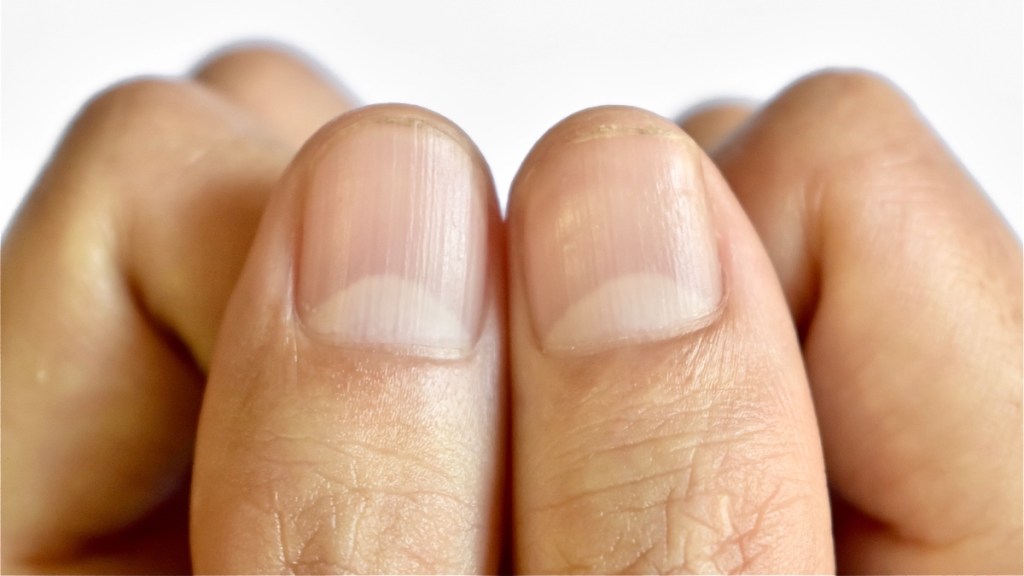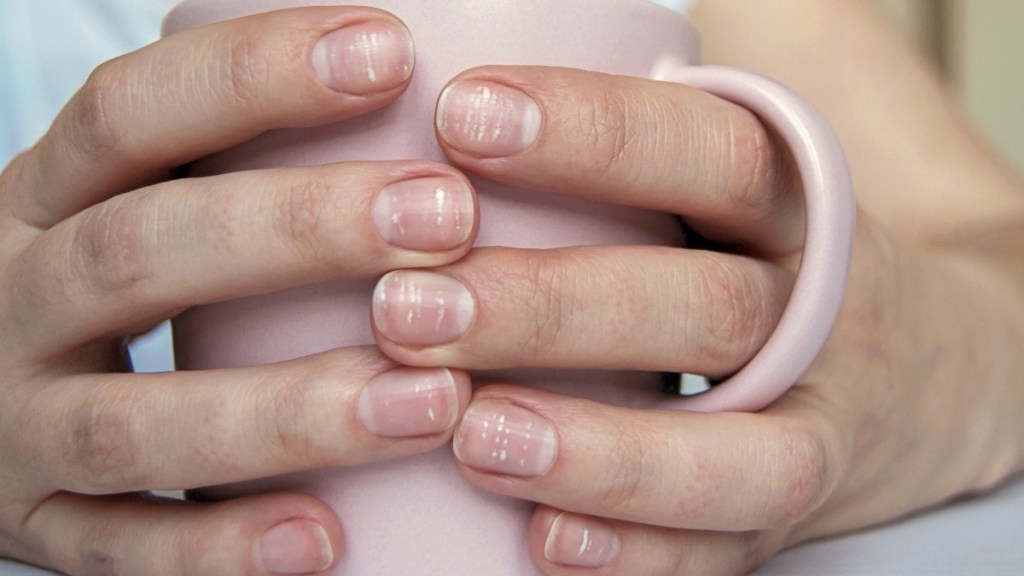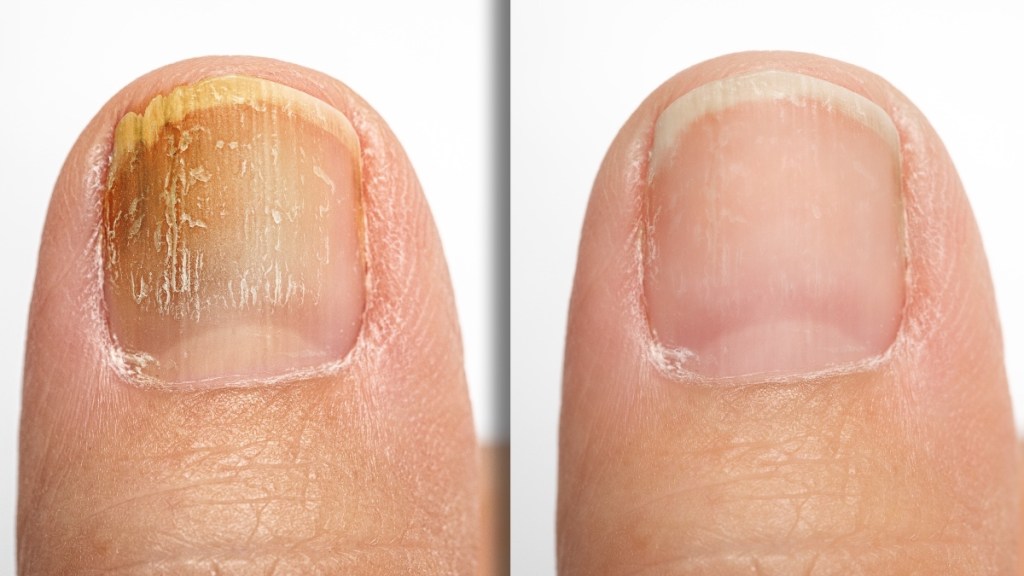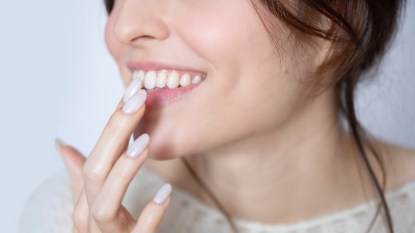Discover What Those Nail Dents Reveal About Your Health + the Nail Symptom that Can Be the First Sign of a Slow Thyroid
A top dermatologist explains what 6 different nail symptoms indicate about your health + easy fixes

Maybe you first noticed them while you were painting your nails and the polish didn’t go on smoothly — those dents that run from one side of the nail to the other and create little valleys where the polish pools (or doesn’t cover at all). Or perhaps you rub your nails when you’re stressed and felt them during a particularly challenging day. But what exactly are these dents? It turns out your nails reveal more about your health than you may think. Here, a top dermatologist reveals what causes dents in nails and how to fix them. Plus, we share more common nail changes to watch out for and explain what they could signal about your health.
The two main causes of dents in nails
Nail depressions that run horizontally across the nail plate from one side to the other are called Beau’s lines, says Dana Stern, MD, a New York City dermatologist who specializes in nail care. They’re generally caused by an illness or injury to the nail matrix that temporarily halts growth. “Any time the nail ceases to grow, a depression forms,” Dr. Stern explains.
1. Injury can cause dents in nails
The nail matrix is responsible for production and growth of the hard nail, says Dr. Stern. It begins under the skin behind the cuticle and extends up into the lunula, the white, half-moon-shaped area at the base of the nail. Anything that injures this area, such as your fingers getting caught in a closing car door, can interrupt nail growth. And while injury is one of the most common causes of dents in nails, daily habits like prolonged picking at your nails or cuticles or longterm use of gel or acrylic nails can also trigger Beau’s lines over time.

2. Health conditions can cause dents in nails
But what if you have dents in your nails and haven’t experienced an injury or cuticle damage? An underlying health issue is likely to blame. Illnesses, especially those with high fevers, can sometimes trigger Beau’s lines, Dr. Stern notes. Other common health conditions that can affect your nails include inflammatory conditions such as psoriasis, metabolic conditions such as diabetes, and vascular conditions that diminish blood flow to the fingers such as peripheral artery disease. (Click through to discover natural treatments for peripheral artery disease.)
What’s more, researchers reporting in the Indian Journal of Dermatology, Venereology and Leprology found that low levels of zinc are a common cause of Beau’s lines. And they note that one’s risk of future nail dents can be lowered simply by including more zinc-rich foods like nuts, whole grains and seafood into your daily diet. (Click through to learn how dents is nails can be an early warning sign of psoriatic arthritis, too.)
Examples of dents in nails caused by Beau’s lines
Not sure if the dents in your nails are Beau’s lines? Unlike more common vertical ridges, Beau’s lines are horizontal indentations that can range from deeper to more shallow, as shown in the photos below.
Beau’s Lines https://t.co/Yfa28sk1GY #BeausLines #Nailhealth #Dermatology pic.twitter.com/63EnbdmMRg
— News Medical (@NewsMedical) September 22, 2016
The best way to treat dents in nails
Although existing Beau’s lines can’t be treated, they’ll eventually go away as the nail continues to grow, assures Dr. Stern. “For the average adult, it takes six months for the fingernail to replace itself,” she notes. “So if the Beau’s line is just appearing past the cuticle, expect close to six months of outgrowth.” Eager to speed results? There are a few simple steps you can take to encourage new growth and strengthen your nails to thwart breakage.
1. Add collagen to your coffee
Simply stirring one scoop of a bioactive collagen powder into your morning coffee, tea or smoothie can significantly speed nail growth and decrease the frequency of broken nails by 42%, say researchers in the Journal of Cosmetic Dermatology. Collagen feeds the nail bed, contributing to health of the nail matrix that grows new nail. A brand with the study-proven type of collagen: Sparkle Skin Boost Plus Verisol Powder (Buy from Amazon, $39.50). (Click through to discover the best collagen for women and the benefits of marine collagen.)

2. Supplement with biotin
Biotin, also known as vitamin B7, plays a key role in healthy nail growth. As women age, more biotin is rerouted to support organs like the heart, which can weaken nails and slow their growth, explains dermatologist Peyman Ghasri, MD. Fortunately, supplementing with this nutrient daily can increase nail thickness by 25% in just two weeks, according to a study out of Columbia University. This increase in thickness can help make the dent less noticeable and thwart breakage that can hamper growth. Dr. Ghasri advises taking 2.5 mg. (the study-proven dose) of biotin daily. One to try: Nature Made Biotin Extra Strength 2500 mcg (Buy from Amazon, $14.99). (Click through to discover foods rich in biotin for hair and nail growth.)
3. Moisturize daily
Go ahead and give your hands a little TLC! A study published in the journal Dermatology and Therapy found that keeping nails moisturized by applying petroleum jelly or lanolin reduced nail brittleness and increased nail health and strength. This means your nails will grow in longer and stronger. (Click through for 10 more smart uses for petroleum jelly.)
5 other nail conditions — and what they reveal
While issues ridges or dents in nails are more common, there are other visible nail abnormalities you may notice that can signal an underlying nutrient deficiency or health concern. Here are a few of the most common, what they mean, and how to correct them.
1. Koilonychia
Commonly referred to as “spoon nails,” this condition causes the nail to become concave so it actually looks like a spoon, says Dr. Stern. “It can be due to iron deficiency and other causes including disorders where iron isn’t metabolized effectively, such as hemochromatosis and Plummer-Vinson syndrome.” Treating the underlying issue can normalize the nails, she adds. “In addition, aging can cause age-related koilonychia. Anyone who suddenly develops spoon-shaped nails should have a work-up by their physician.” For a visual example of koilonychia, clubbing, Beau’s lines and more, check out the video below.
2. Brittle nails
If your nails are soft and bend or flake, it may be a sign of a sluggish thyroid, which can also make you feel foggy and slow your metabolism. First, visit your doctor for thyroid testing. Then in addition to any meds he or she might prescribe, consider ashwagandha. Research in the Journal of Alternative and Complementary Medicine found taking 600 mg. of the adaptogenic root daily boosts levels of thyroid hormones (T3 and T4) by up to 42%, improving thyroid function and nail health. (Click through to learn more about ashwagandha and how it can help speed weight loss and how ashwagandha heals your thyroid.)
3. Nails with white spots
Nails that are sprinkled in white spots could signal a deficiency in immune-boosting zinc, essential for warding off colds and viruses. Thankfully, you can boost zinc levels simply by sucking on one 20 mg. zinc lozenge daily. Not only will this repair your nails, but a study in JRSM Open found it’ll help reduce the days you’re sick with a cold by 48%.

4. Clubbing
This over-curvature of the nails makes them look like clubs, says Dr. Stern, while the skin surrounding then ails is enlarged and spongy. Thoracic disorders including emphysema, Barrett’s esophagus, chronic obstructive pulmonary disease (COPD), hiatal hernia and thyroid disease are behind 80% of clubbing symptoms, she adds, saying treating the underlying medical cause will help nails return to normal. (Click through to see how one woman used iodine-rich sea kelp to boost her sluggish thyroid.)
5. Nail fungus
More than half of us have nail fungus (aka onychomycosis), which can cause nails to yellow and thicken into ridges. A fungal infection is more common on toenails, but can also appear on fingernails. Consider treating it with a fungus-fighting polish made with garlic bulb and tea tree oil that kills spores while making nails look prettier. Bonus: Research finds nixing nail fungus cuts levels of heart-hampering C-reactive proteins in your blood in half, lowering your risk of heart disease and stroke. One to try: Dr’s Remedy Enriched Nail Polish (Buy from RemedyNails.com, $17.95). (Click through for more easy ways to get rid of toenail fungus.)

For more ways to keep your nails strong, healthy and polished to perfection:
How to Get Rid of Toenail Fungus—And the Key Post-Infection Step That Ensures It Never Comes Back
What Is a Medical Pedicure? (And Do You Need One?)
Top Manicurists: The Best Nail Designs of 2023 That Put Happiness At Your Fingertips
This content is not a substitute for professional medical advice or diagnosis. Always consult your physician before pursuing any treatment plan.













